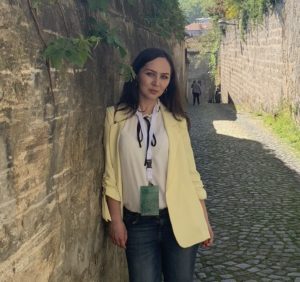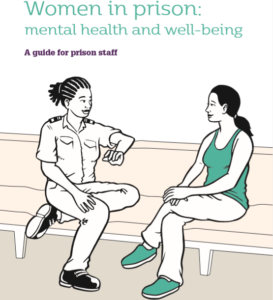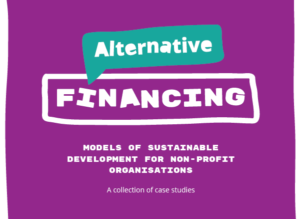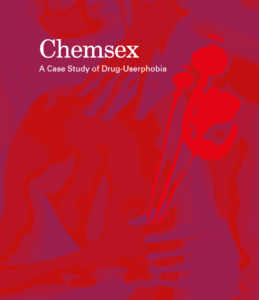Nowadays Kyrgyzstan is recognized as one of the most advanced countries in the world in regards to delivery of the harm reduction and HIV care and treatment programs in prisons (details here).
At the moment here, in the penitentiaries, there are 5 active programs: syringe exchange program, methadone maintenance treatment program, rehabilitation program “Atlantis”, Center for Rehabilitation and Social Adaptation “Clean zone” and “Start Plus” program.
 Dina Masalimova, AFEW-Kyrgyzstan program manager, explained what kind of work is done in this field in the country, and which significant results have already been achieved.
Dina Masalimova, AFEW-Kyrgyzstan program manager, explained what kind of work is done in this field in the country, and which significant results have already been achieved.
Dina, could you please describe the programs for inmates? What do they look like?
A pilot program on needle and syringe exchange was introduced in Kyrgyzstan in 2002, in one of the prisons with a modest reach of 50 people. A year later the program was expanded to 3 prisons, and then several more. Today there are 14 syringe exchange stations (SES) in the penitentiary system. They work in all the prisons except for the facility for underage convicts. Also, syringe exchange services are provided in the 2 largest detention centers. An actual number of SES clients in 2018 amounted to over 1300 people. They received syringes either in person, or through a secondary exchange conducted by volunteers. Aside from the sterile injection equipment you can also find other protection items at the stations – alcohol wipes, condoms; and HIV blood tests are done here too. Those clients that would like to decrease or fully stop the injecting drug use are forwarded to the methadone maintenance treatment stations.
The methadone maintenance treatment program was started in the country’s prisons over 10 years ago – in 2008. Today there are already 9 stations in the penitentiaries, and the number of clients is over 350. These programs are conducted by the State Penitentiary Service with the support of the Global Fund To Fight Aids, Tuberculosis And Malaria, as well as Center for Disease Control (CDC).
Aside from the harm reduction programs there is a program aimed at the full withdrawal from drug use in prisons. In a number of places the “Atlantis” program based on the famous model “12 steps” is active. The program graduates can serve their remaining sentence time in the Center for Rehabilitation and Social Adaptation “Clean zone”. “Clean” means that it’s free from drugs. There is a full-scale program of rehabilitation and preparation for sober life outside of prison there.
Over the past 5 years we also were active in delivering services directly to inmates. For instance, our consultants have supported prisons’ health system by providing peer-to-peer consultations and HIV testing, as well as supported inmates before and after their release from prison. For a long time this program has been implemented with the support of USAID. Soon it will be continued thanks to the financial and technical support of ICAP (international program by Columbia University’s Mailman School of Public Health).
How are these programs created, and who delivers them?
As a rule, these programs are created based on the actual needs of the most vulnerable groups of prisoners – people living with HIV and/or using drugs. And these programs are also delivered by the representatives of these communities.
We approach the program in a flexible way and always try to improve it so that it remains relevant. For example, one of our recent additions to the program is working with the convicts that were rejected by the prison subculture. Due to the unspoken prison rules this group of prisoners has the lowest level of access to medical and social support and faces a high level of stigma and discrimination from the other convicts, and often also from the prison staff.
Could you share some results of these programs?
All the programs currently active in the country are aimed at reaching the ambitious goal 90-90-90. Now almost all inmates in prison are being tested for HIV “at the entrance”, and a vast majority of people living with HIV are formally in treatment. Why “formally”? The viral load indicators show that quite a few of inmates don’t use it. In prisons there are a lot of myths about HIV and antiretroviral therapy, and during in-person conversations many patients admit that they simply throw medicines away. Because of that, the main goal of our project is to increase the number of convicts who live with HIV with undetectable virus load.
Over the years we achieved great results. For instance, in prison #31 the number of people who are adherent and have a suppressed virus load has grown from 15% to 68%, and in prison #16 – from 33% to 66% in the past three years. We are especially proud of two prisons – #2 and #47, where we’ve already reached the second and third “90”.
All these programs are mainly targeting male convicts. Are there any special programs for female inmates, for pregnant women?
In Kyrgyz prisons there are only 10 female inmates living with HIV. However, it is also important to consider their needs while planning measures in response to HIV-epidemic. We approach work in female prisons quite reverently and are trying to make sure our programs are gender-sensitive. In one prison there was a women self-help group focusing on gender violence prevention. Also we partner with NGO “Asteria”, which runs a women’s center supported by AFEW-Kyrgyzstan and open for women released from prison. Many of the center’s clients are former inmates, and the help and support program includes temporary lodging, provision of food and hygiene packages, peer consulting on HIV, sexual and reproductive health and rights (SRHR) and opioid substitution treatment (OST), as well as provides access to gynecological services.
What is the prisoners’ attitude towards such programs?
Inmates perceive this program in a very positive way. Slowly but surely our team managed to win their trust and involve them into the dialogue about their health. It’s important to understand that health is far from the first priority for a person in prison. Unfortunately, current conditions of prisons make basic survival the main priority, and HIV is perceived as a far removed problem for many of them. Our peer consultants have their own experience of living with HIV in a prison, so they can show by their own example how one could solve upcoming problems.
Could you name the main current problem for prisoners with HIV in Kyrgyzstan?
One of the main problems is the lack of medical staff in the penitentiary system. In a number of large prisons in the country there are no doctors with higher medical degree. All the work on supporting prisoners’ health is put on the shoulders of a small team of paramedics. Of course, very often they have no time or knowledge needed to perform quality work on supporting inmates with HIV. We also try to help in such cases. For example, in prison #16 there was no doctor for a whole year, and our organization set up weekly visits of a doctor from the Republican AIDS center in order to support the patients.
It is often said that many prisoners don’t trust prison staff, including health workers…
Yes, it’s a separate and quite serious problem, and the consequence of it is the unwillingness of prison inmates to follow doctors’ recommendations. Our consultants serve as a certain “bridge”, which helps to build trust-based relationships between doctors and patients. For instance, with the patients’ agreement they take the results of viral load and cd-4 tests and thoroughly explain their meaning to the patients, e.g. the influence of the therapy on those indicators etc. We try to find individual approach to everyone. For many people the possibility to have a family and healthy children when they reach undetectable viral load becomes the best motivation for treatment.
It seems that peer-to-peer consulting is a really life-saving tool when it comes to fighting for the health of prisoners living with HIV, isn’t it?
 Certainly! We have so many stories that prove it. For instance, the story of Alexander. He learned about his positive HIV-status in 2013. His prison mates gave him a clear verdict that he would die soon. Needless to say, he was in great shock. He didn’t have any access to information, and doctors didn’t explain much. On the verge of desperation he started to use more drugs. He looked at the people with positive HIV-status around him, and they were dying one after another. He also waited for his turn.
Certainly! We have so many stories that prove it. For instance, the story of Alexander. He learned about his positive HIV-status in 2013. His prison mates gave him a clear verdict that he would die soon. Needless to say, he was in great shock. He didn’t have any access to information, and doctors didn’t explain much. On the verge of desperation he started to use more drugs. He looked at the people with positive HIV-status around him, and they were dying one after another. He also waited for his turn.
In 2016 peer consultants from the Action against HIV project started to come to the prison. One of them – Evgeniy – really impressed him. He was living with HIV himself, but he didn’t look like he was dying at all, quite the contrary. During one conversation with a peer consultant Alexander got more information than in the previous 3 years of his life with positive HIV-status. At that moment he told himself: “Enough. I choose life”. He started treatment and quite soon reached undetectable viral load.



